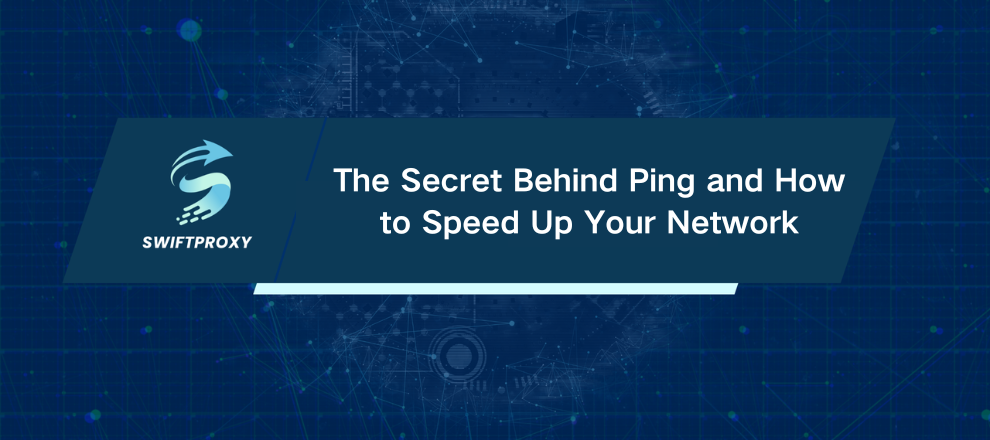The Secret Behind Ping and How to Speed Up Your Network

Picture that you're mid-game, your commands delay by a fraction of a second, and suddenly you're lagging behind. Or, your web scraper stalls, missing critical data because the connection drags. What's happening? The culprit is often something simple but crucial—ping.
Ping measures how quickly data travels between your device and a server. It's the heartbeat of your connection. Lower ping means faster response. Higher ping? Brace yourself for delays, interruptions, and frustration.
What Does Ping Mean
Ping is a test that sends a tiny packet of data from your computer to a target server and waits for a reply. The round-trip time, measured in milliseconds (ms), reveals your network's latency. The faster the return, the more responsive your connection feels.
Think of it as a digital echo. The closer the server or proxy, the quicker the bounce-back. It's a straightforward test, but the insights it provides are invaluable for everything from gaming and video calls to complex automation like web scraping.
Why Ping Is More Important Than You Might Think
Bandwidth grabs headlines—it tells you how much data can flow at once. But ping? Ping tells you how fast a single data packet completes its journey. That speed matters.
In live gaming, a high ping turns your avatar into a sluggish puppet. In video conferencing, it causes those awkward audio lags that kill the flow. For scrapers and bots, every millisecond saved means more requests handled, fewer errors, and smoother data collection.
If your business depends on proxies, ping is your performance scoreboard. Lower latency between your device, proxy, and the target server directly translates to faster, more reliable operations.
What Drives Ping Up or Down
Several factors tangle with ping. Knowing them helps you troubleshoot and improve connection speed:
Distance: Data can't travel faster than light. Connecting to a distant server naturally takes longer.
Network Congestion: Too much traffic on a network causes delays, just like rush-hour gridlock.
Routing: Data often hops through multiple servers. Longer, inefficient paths mean higher ping.
ISP and Security Layers: Firewalls, filters, or throttling by your provider can add milliseconds.
Connection Type: Wired connections usually beat Wi-Fi or cellular for latency.
Proxy Location and Quality: Adding a proxy can help or hurt ping, depending on where it sits relative to you and your target.
When Proxies Help Your Ping and When They Don't
A proxy is an extra pit stop on your data's journey. That might sound like it adds delay. Sometimes it does. But if your proxy is strategically placed closer to your target server than you are, it can actually shrink your data's travel time.
Imagine you're in New York scraping a German website. Connecting directly might send your data on a global trek. But routing through a proxy in Frankfurt? Your data hops a shorter distance overall, slashing latency and speeding up your tasks.
That's the magic of location-aware proxies.
But beware a badly positioned proxy—far from both you and your target—can introduce frustrating delays. Choosing a proxy provider with a well-distributed, performance-optimized network is essential.
Measuring Ping Like a Pro
Grab your command line and ping a server:
ping google.com
You’ll see response times in milliseconds. What do these numbers tell you?
Under 50 ms: Excellent—near-instant responsiveness.
50 to 100 ms: Solid performance for most uses.
100 to 200 ms: Noticeable delays, problematic for real-time needs.
Over 200 ms: Lag territory, serious performance hits likely.
Look beyond the numbers. Consistency matters. Frequent spikes or jitter hint at deeper routing problems or overloaded servers.
If you're using proxies and your ping bounces wildly, it's time to re-evaluate your provider or rotate your IPs.
Actionable Tips to Reduce Ping With Proxies
Pick Proxies Near Your Target: The shortest route wins. Physical proximity beats everything else.
Invest in Quality Infrastructure: Free or consumer proxies often overload their networks. Premium providers use optimized datacenters and residential proxies to keep latency low.
Distribute Your Requests: Load balancing across multiple proxies prevents bottlenecks and keeps latency down, especially for large-scale scraping.
Test and Rotate Frequently: Ping changes. Regular testing and smart IP rotation maintain stable, low-latency connections.
Final Thoughts
Ping isn't just a technical metric; it is the lifeline of your online activities. Understanding what affects it and how proxies play a role can transform your experience, whether you're gaming, streaming, or scraping data. By choosing the right proxies, monitoring performance, and staying proactive, you ensure every millisecond counts toward speed, reliability, and success.





















































